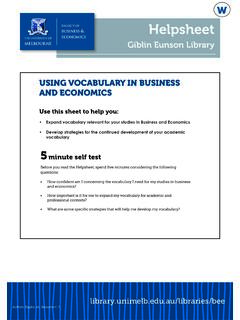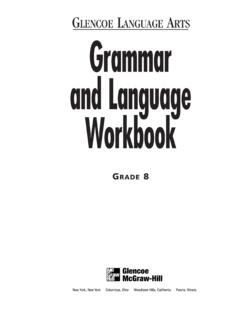Transcription of The Meaning of Language - Harvard University
1 The Meaning of Language 01:615:201 Introduction to Linguistic Theory Adam Szczegielniak Copyright in part: Cengage learning The Meaning of Language When you know a Language you know: When a word is meaningful or meaningless, when a word has two meanings, when two words have the same Meaning , and what words refer to (in the real world or imagination) When a sentence is meaningful or meaningless, when a sentence has two meanings, when two sentences have the same Meaning , and whether a sentence is true or false (the truth conditions of the sentence) Semantics is the study of the Meaning of morphemes, words, phrases, and sentences Lexical semantics.
2 The Meaning of words and the relationships among words Phrasal or sentential semantics: the Meaning of syntactic units larger than one word Truth Compositional semantics: formulating semantic rules that build the Meaning of a sentence based on the Meaning of the words and how they combine Also known as truth-conditional semantics because the speaker s knowledge of truth conditions is central Truth If you know the Meaning of a sentence, you can determine under what conditions it is true or false You don t need to know whether or not a sentence is true or false to understand it.
3 So knowing the Meaning of a sentence means knowing under what circumstances it would be true or false Most sentences are true or false depending on the situation But some sentences are always true (tautologies) And some are always false (contradictions) Entailment and Related Notions Entailment: one sentence entails another if whenever the first sentence is true the second one must be true also Jack swims beautifully. Jack swims entails but does not entail Jack swims.
4 Jack swims beautifully When two sentences entail each other, they are synonymous, or paraphrases Jack postponed the meeting Jack put off the meeting When one sentence entails the negation of another sentence, the two sentences are contradictions Jack is alive Jack is dead Ambiguity Our semantic knowledge also tells us when words or phrases have more than one Meaning , or are ambiguous Syntactic ambiguity arises from multiple syntactic structures corresponding to the same string of words The boy saw the man with the telescope Lexical ambiguity arises from multiple meanings corresponding to the same word or phrase This will make you smart Compositional Semantics Compositional semantics.
5 To account for speakers knowledge of truth, entailment, and ambiguity, we must assume that grammar contains semantic rules for how to combine the meanings of words into meaningful phrases and sentences The principle of compositionality asserts that the Meaning of an expression is composed of the Meaning of its parts and how the parts are combined structurally Composi'onality as set intersec'on [NP Blue books] Blue set of everything blue Books Set of all books Blue Books =[NP Blue books] Verbs are more complex they map rela'onships Semantic Rules Semantic Rule I.
6 If the Meaning of NP (an individual) is a member of the Meaning of the VP (a set of individuals), then S is TRUE, otherwise, it is FALSE Word Meaning Jack refers to the individual Jack swims refers to the set of individuals that swim If the NP, Jack, is among the set of individuals that swims (the VP) then the sentence is TRUE Semantic Rules Jack kissed Laura. Semantic Rules If the NP Jack is among the set of people who kissed Laura (the VP), then the sentence is TRUE Seman'c Rules The Meaning of the sentence Jack kissed Laura is first derived by applying Seman'c Rule II, which establishes the Meaning of the VP (establishes the set of people who kissed Laura)
7 Then, Seman'c Rule I applies to determine the Meaning of the en're sentence (establishes whether or not Jack in par'cular is in the set of people who kissed Laura When Compositionality Goes Awry: Anomaly An anomalous sentence: Colorless green ideas sleep furiously This sentence is syntactically fine, but contains semantic violations such as describing ideas as both colorless and green Other sentences are uninterpretable because they include nonsense words: He took his vorpal sword in hand When Compositionality Goes Awry.)
8 Metaphor Metaphors are sentences that seem to be anomalous but are understood in terms of a meaningful concept To understand a metaphor we must understand the individual words, the literal Meaning of the expression, and facts about the world To understand Time is money you need to know that in our society people are often paid according to the amount of time worked When Compositionality Goes Awry: Idioms Idiomatic phrases are phrases with meanings that cannot be predicted based on the meanings of the individual words The usual semantic rules for combining meanings do not apply drop the ball put his foot in his mouth hit it off All languages have idioms, but idioms are rarely directly translatable kick the bucket = estirar la pata to stretch the (animal) leg Lexical Semantics: Reference Referent.
9 The real-world object designated by a word Jack, the happy swimmer, my friend, and that guy can all have the same referent in the sentence Jack swims. But, some NPs do not refer to any particular individual, such as: No baby swims. While the happy swimmer and Jack may refer to the same individual in some cases, the happy swimmer means something extra: The happy swimmer is happy. Jack is happy. Lexical Semantics: Sense Sense: an element of Meaning separate from reference and more enduring; the manner in which an expression presents the reference Barack Obama The President Michelle Obama s husband The word unicorn has sense but no reference Proper names tend to have reference but no sense Sometimes two proper names have the same referent (Unabomber & Ted Kaczynski).
10 These pairs of nouns are called coreferential These have the same reference but different senses Lexical Relations: Synonyms Synonyms: words or expressions that have the same Meaning in some or all contexts apathetic, indifferent sofa, couch Some assert that there are no two words with exactly the same meanings After the Norman invasion of England in 1066, many French words of Latin origin entered the Language , giving rise to synonymous pairs: English: heal Latin: recuperate English: send Latin: transmit Lexical Relations: Antonyms Antonyms are words that are opposite in Meaning Complementary antonyms: alive/dead, present/absent, awake/asleep alive = not dead, dead = not alive Gradable pairs: no absolute scale big/small, hot/cold, fast/slow, happy/sad Some pairs of gradable antonyms contain a marked and an unmarked term, with the unmarked term being the one used in questions of degree: How high is the mountain?











